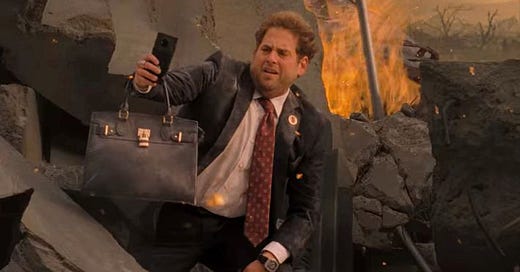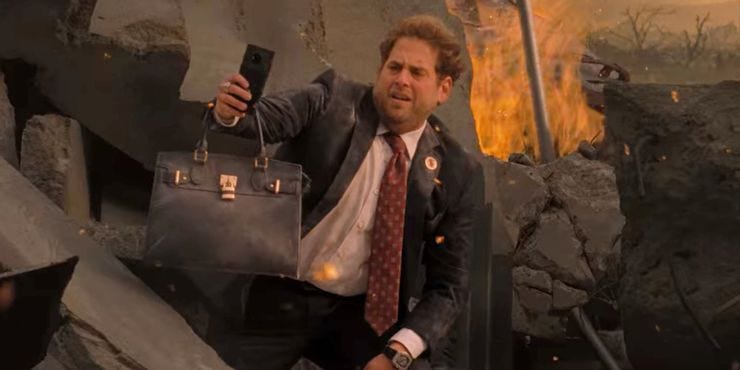🦄 The stories we tell ourselves 🥳
Why you're not keeping your New Year's resolution this year 😥
Climate Solutions // I S S U E # 6 4 // R E S O L U T I O N S
A different type of climate denial
By Michael Coren
At least 80% of people who make New Year's resolutions this year won’t be sticking to them next December. Almost all vows, say researchers who study this sort of thing, are commitments to be a lighter, less addicted, or otherwise healthier version of ourselves. Yet the resolutions that fail tend to share one thing in common: their premise is about saying no.
Denial, science suggests, is not that motivating. A promise to “lay off junk food” is one most of us are doomed to break. The “No Cheetos” diet crumbles in the face of temptation. It’s a white-knuckle exercise convincing ourselves of something we don’t really believe: I’m strong enough to resist temptation—forever.
What seems to be far more effective is framing our goals as something we do want, not just something to avoid. Eating a delicious salad every day, fresh romaine with a mustard balsamic vinaigrette? Doable. Vowing never to sneak another donut again. Not going to happen (and who would want to live in that world anyway?). Denial works for a while, but desire motivates for a lifetime.
What humans need to sustain action, in other words, is a story that makes us feel good: What is the better—or cooler—world we’re building?
Subscribe to Hothouse today for a regular dose of stories like this: an in-depth look at how you can engage on the climate in your own life, right in your inbox.
You may have heard, “The future belongs to optimists.” Pessimism, at times, is justified. But those building what’s next are those who believe in something better (if only they are the only ones really trying). That’s not a value judgment, it’s a logical outcome. Pessimism is a bad strategy in the long game.
So that’s made me fascinated by the stories we tell ourselves about climate change. Normally, we think of stories as bedtime tales or novels. Fantasies. But everyday stories construct our reality. Our world is woven out of the stories we tell ourselves, the ones people tell us, and the ones we all believe.
Money, in a material sense, is one of the most compelling stories we all tell each other about the nature of value and the worth of green slips of paper. Even our decision to celebrate New Years Day on January 1 is a story about a “new” year. The Egyptians marked their new year after the first flooding of the Nile. Babylonians popped their champagne on the first full moon in spring. It wasn’t until Julius Caesar, a devotee of the two-faced Janus, the god of beginnings, that January 1st became the official threshold of another year’s passing.
So when it comes to climate action, are we telling a desirable story? I don’t mean what happens if we do nothing. I mean a story about the world we’ll get if we do act. If I asked you to name a few climate stories, most would be dystopic: Water Knife (US states descend into a water war), Don’t Look Up (social media distracts us from a killer comet), The Uninhabitable Earth (life after catastrophic warming), Snowpiercer (geoengineering gone awry), and (appropriately) Annihilation, to name a few. Given what’s at stake, that’s understandable. Dystopia is not too strong a word for the world awaiting should we do nothing.
Tales of sacrifice make for thrilling movie plots. They do little to sway most people in their personal lives or politicians in their voting. Telling people to no longer drive trucks and SUVs (the world’s most popular class of cars) or fly on vacations will be dead on arrival in Washington DC and at the average family dining table. No matter how rational this advice may be in an overheating world, both SUVs and flights are still climbing.
What’s missing is a positive story about the world we want to build. This is not merely the absence of extreme weather disasters. I mean a story about the world we’ll get if we act. It’s a vision for the kind of human civilization we seek, even if climate change was not an imminent threat.
If we’re going to meet people where they are, we’ll need a new narrative. Luckily, it seems almost everyone is willing to do something. In surveys, more than 70% of people say they will pay at least a bit more for green products and services (see below). As you bring down these “green premiums,” as Bill Gates calls the surcharge on building the low-carbon economy, people enthusiastically embrace them.
But only a few are willing to pay a lot. To put a number on this, once prices rise by 25%, green motivations melt away for about 95% of people. We all want to be good when it’s convenient.
One person who understands this is Elon Musk.
How to sell the world’s most popular electric car
People think Tesla sells electric cars. That’s not quite true. It makes them, but it sells something different.
GM, for example, had been selling electric vehicles (EVs) for years before Tesla arrived. First, it was the EV1 in 1997. More recently, it was the Chevy Bolt. Both are engineering marvels. Both fell flat at the dealership. A few true believers bought them. The rest of the public shrugged. The EV1 sold about 1,000 cars between 1997 and 2000. The Bolt, which has proved modestly popular, has sold just over 100,000 cars since 2016.
Tesla, founded in 2003, has now sold more than 2 million electric cars, at prices far higher than GM’s, and will churn out more than a million cars this year. Its factories can’t keep up with demand. Wait times now stretch into 2023.
What happened? Tesla’s technology is good (even if its build quality always isn’t). But that wasn’t the reason. Tesla’s CEO Elon Musk knew he wasn’t selling cars. He was selling a vision of the future—an improbable, gonzo, exciting electric future that customers felt they could be a part of. In his 2006 “Secret Tesla Motors Master Plan,” Musk promised to make an expensive, electric sports car he admitted would do almost nothing about greenhouse gas emissions— at least at first. “But that misses the point,” he wrote in the blog post. The plan—following the path of almost every new technology— would be to use the money from the fancy sports cars to build an affordable car, and then an even more affordable car, and finally supply zero-emission solar electricity and batteries to power everything.
Customers loved it. The launch of its Model 3 sedan saw nearly half a million people plop down $1,000 to reserve a car that hadn’t been built yet, the most successful product launch of all time. Today, Tesla's Model Y and Model 3 are the most popular premium vehicles in the US—of any kind.
Tesla buyers felt like they could become part of a story (a hero’s story, specifically) in which they were advancing a crazy, impossible, exciting future powered by sunshine and batteries. As a result, Tesla ($1.1 trillion market capitalization) is now worth more than the rest of the major automakers combined.
A brief word from our sponsor // A custom jeans without the waste 👖
We are proud to have Unspun sponsor the Resolution issue. This month, anyone who signs up to give feedback for Unspun will get a free $40 gift card for you or a friend. We chose Unspun and their custom-made jeans because the company’s mission is aligned with a low-carbon world: a 1% reduction in global CO2 emissions from the fashion industry. Good for the planet 🌏 and your 🍑. Add your email here: unspun.io/hothouse 🤩
The big story
So what’s the climate story we need to tell in 2022 to achieve a net-zero world in 2050? In many ways, the early stories are all around us. The low-carbon economy is, ultimately, about eliminating greenhouse gas emissions. But what’s good for emissions, it turns out, is generally good for people and the biosphere.
It’s not a free lunch, exactly. The bill to shift the global economy to clean energy will be hefty: $30.3 trillion by 2030. But like an investment that pays dividends every year, the final cost is actually negative and measured in trillions of dollars. “I can understand how this is hard to believe, but there is a misconception that decarbonizing will be 'costly,'” says Ramsay Siegal, a partner at Earthshot Ventures investing in new climate technologies. “In reality, the solutions that scale offer a better experience and/or meaningful cost savings compared to the status quo.” Those costs are not just denominated in dollars. It’s in lives.
So next issue, we’ll present you with a few of the stories we can tell about an alternate climate future—the start of humanity’s greatest transformation since the Industrial Revolution, perhaps since the advent of agriculture.
All of it is technically possible tomorrow. We just need to choose the kind of future we want to invest in, today.
What vision of the future motivates you the most? It's a choose-your-own-adventure storybook come to life 🧚🏻
A safe and accessible natural world for my children to grow up and enjoy. 🏞
A more community-centric and slower-paced way of life. 🍵 🫖 🍰
We’ll see you in two weeks! Hothouse is switching to a bi-monthly publishing cycle. We want to bring you the best stories, and investing more time in each one will let us do that.
Hothouse is a weekly climate action newsletter written and edited by Mike Coren and Cadence Bambenek. We rely on readers to support us, and everything we publish is free to read.











Interesting point of view! I recently watched a documentary about how we're destroying the planet and causing the climate change. But in the end, they show how we could reverse it and how much better like could be, giving specific examples. I just loved it! " A life on our planet" with David Attenborough.